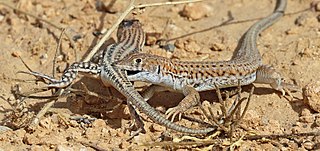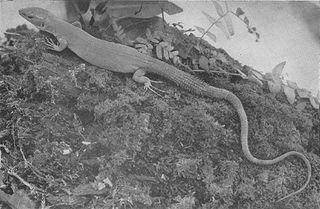
The Lacertidae are the family of the wall lizards, true lizards, or sometimes simply lacertas, which are native to Afro-Eurasia. It is a diverse family with at about 360 species in 39 genera. They represent the dominant group of reptiles found in Europe.

Acanthodactylus is a genus of lacertid lizards, commonly referred to as fringe-fingered lizards, fringe-toed lizards, and spiny-toed lizards.

Gastropholis is a genus of Equatorial African lacertid lizards of the family Lacertidae which is distributed in southern Liberia, Ivory Coast and Ghana, western Cameroon, Equatorial Guinea, Democratic Republic of Congo, eastern Kenya, Tanzania and south to northeastern Mozambique.

Holaspis is a genus of equatorial African lizards in the family Lacertidae. These lizards are capable of gliding flight for distances of 30 meters.

Nucras is a genus of African lacertid lizards, commonly called sandveld lizards.

Philochortus is a genus of lizards of the family Lacertidae. Species of this genus are distributed in Egypt, Algeria, Libya, Mali, Niger, Ethiopia, Djibouti, Eritrea, Somalia, Kenya, Yemen, and Saudi Arabia.

Podarcis is a genus of lizards in the family Lacertidae. Its members look very similar to lizards of the genus Lacerta, to which they were considered to belong until the 1970s. While similar externally and ecologically, Podarcis form a distinct group differing from Lacerta by the construction of the skull and the hemipenis, and by the processes of the caudal vertebrae. They are commonly known as wall lizards. They are native to Europe and northern Africa, and most species are restricted to the Mediterranean region. Wall lizards diversified and hybridized during the Messinian salinity crisis. The Italian wall lizard and the common wall lizard have been introduced to North America, where they have become intermediate hosts for some Acuariidae larvae.

Pseuderemias is a genus of lizards of the family Lacertidae. Common names for the genus are false sand lizards or racerunners.

Bedriaga's rock lizard is a species of lizard in the family Lacertidae. The species is monotypic within the genus Archaeolacerta. It is only found on the islands Corsica and Sardinia. The scientific name Lacerta bedriagae is also used. There are three recognized subspecies.

The Iberian rock lizard is a species of lizard in the family Lacertidae. The species is endemic to Portugal and Spain. Its natural habitats are mountain forests, shrubland, rivers and rocky areas. It is threatened by habitat loss.
Heliobolus spekii, also known commonly as Speke's sand lizard, is a species of lizard in the family Lacertidae. The species is native to East Africa and the Horn of Africa. There are three recognized subspecies.
Latastia boscai, also known commonly as the Eritrea longtail lizard or Bosca's long-tailed lizard, is a species of lizard in the family Lacertidae. The species is native to East Africa and the Horn of Africa. There are three recognized subspecies.
Latastia cherchii is a species of lizard in the family Lacertidae. The species is endemic to Somalia.
Latastia doriai, also known commonly as Doria's long-tailed lizard, is a species of lizard in the family Lacertidae. The species is endemic to the Horn of Africa. There are three recognized subspecies.
Latastia johnstonii, also known commonly as Johnston's long-tailed lizard, the Malawi long-tailed lizard, and the Nyasaland long-tailed lizard, is a species of lizard in the family Lacertidae. The species is native to East Africa.

Latastia longicaudata, also known commonly as the common long-tailed lizard and the southern long-tailed lizard, is a species of lizard in the family Lacertidae. The species is native to northern sub-Saharan Africa. There are four recognized subspecies.
Latastia siebenrocki, also known commonly as Siebenrock's longtail lizard or Siebenrock's long-tailed lizard, is a species of lizard in the family Lacertidae. The species is endemic to Guinea.
Latastia taylori, also known commonly as Taylor's long-tailed lizard or Taylor's longtail lizard, is a species of lizard in the family Lacertidae. The species is endemic to Somalia.
Philochortus hardeggeri, also known commonly as Hardegger's orangetail lizard and Hardegger's shield-backed lizard, is a species of lizard in the family Lacertidae. The species is native to the Horn of Africa.
Philochortus phillipsi, known commonly as Phillips' orangetail lizard or Phillips' shield-backed lizard, is a species of lizard in the family Lacertidae. The species is endemic to the Horn of Africa.













